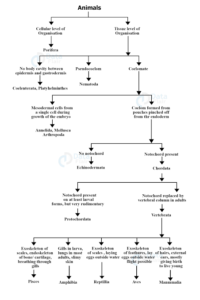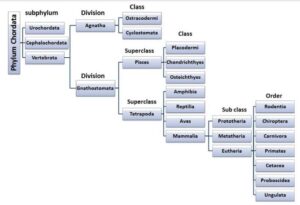Back to: ZOOLOGY 300 Level
WELCOME TO CLASS! You’re most welcome, my star student! I’m really proud of you for showing up again—this commitment to learning is how champions are made. Today, we’re looking at how scientists group chordates. It’s like sorting out different types of suya: beef, chicken, ram… they’re all suya, but they come in different styles! That’s exactly what classification does for animals—it helps us understand how they’re alike and how they differ.
Overview Of Chordate Classification
When we say chordates, we’re talking about animals that have those special features we learnt about—notochord, dorsal nerve cord, pharyngeal slits, post-anal tail, and a ventral heart. But not all chordates are exactly the same. Some have backbones, some don’t. Some swim in water all their lives, while others roam the land. So scientists use classification to organise them into groups that make sense.

Major Divisions of Chordates
Chordates are mainly divided into three subphyla:
- Urochordata (Tunicates) – These are sea animals, mostly small and soft-bodied. You might not believe it, but during their early life stage (as larvae), they have all the chordate features. However, when they grow up, they lose most of these traits and look more like simple bags stuck to rocks. An example is the sea squirt. It’s a bit like that friend who was very active in primary school but became quiet in university—still part of the family, just grown differently!
- Cephalochordata (Lancelets) – These ones are more consistent. They keep all the chordate characteristics throughout their lives. They look like tiny fish but have no proper head. The popular example is Amphioxus. Even though they’re small and don’t get much attention, they are very important for studying evolution and development.
- Vertebrata (Craniata) – Now these are the big stars! This group includes fish, amphibians, reptiles, birds, and mammals. The major difference is that vertebrates have a backbone (vertebral column) and a well-developed head with a brain inside a skull. This is the group that includes humans—you and me!
Classes of Vertebrates
The vertebrates are further grouped into different classes based on their features:
- Pisces (Fish) – Live in water, breathe through gills, and have fins. Examples: tilapia, catfish.
- Amphibia (Amphibians) – Can live both in water and on land. They breathe through their skin and lungs. Examples: frogs, toads.
- Reptilia (Reptiles) – Have dry, scaly skin. They lay eggs on land. Examples: snakes, lizards.
- Aves (Birds) – Have feathers, lay eggs, and most can fly. Examples: chicken, eagle.
- Mammalia (Mammals) – Have hair or fur, give birth to live young (mostly), and feed them with milk. Examples: goats, dogs, humans.

Understanding this classification helps us know how living things are connected. It’s like a big family tree that shows who your cousins, aunties, and uncles are—even if you’ve never met them before.
Summary
- Chordates are classified into Urochordata, Cephalochordata, and Vertebrata.
- Urochordates have chordate features only in the larval stage.
- Cephalochordates retain all chordate features for life.
- Vertebrates have a backbone and are divided into classes like fish, amphibians, reptiles, birds, and mammals.
Evaluation
- List the three main subphyla of chordates.
- What makes vertebrates different from the other chordates?
- Mention one example each of a urochordate and a cephalochordate.
- Which class of vertebrates does a frog belong to?
You’re amazing and getting smarter with every lesson! Afrilearn is proud to be part of your journey. Keep that fire for learning burning bright, and let’s keep moving forward together. You’ve got this!
